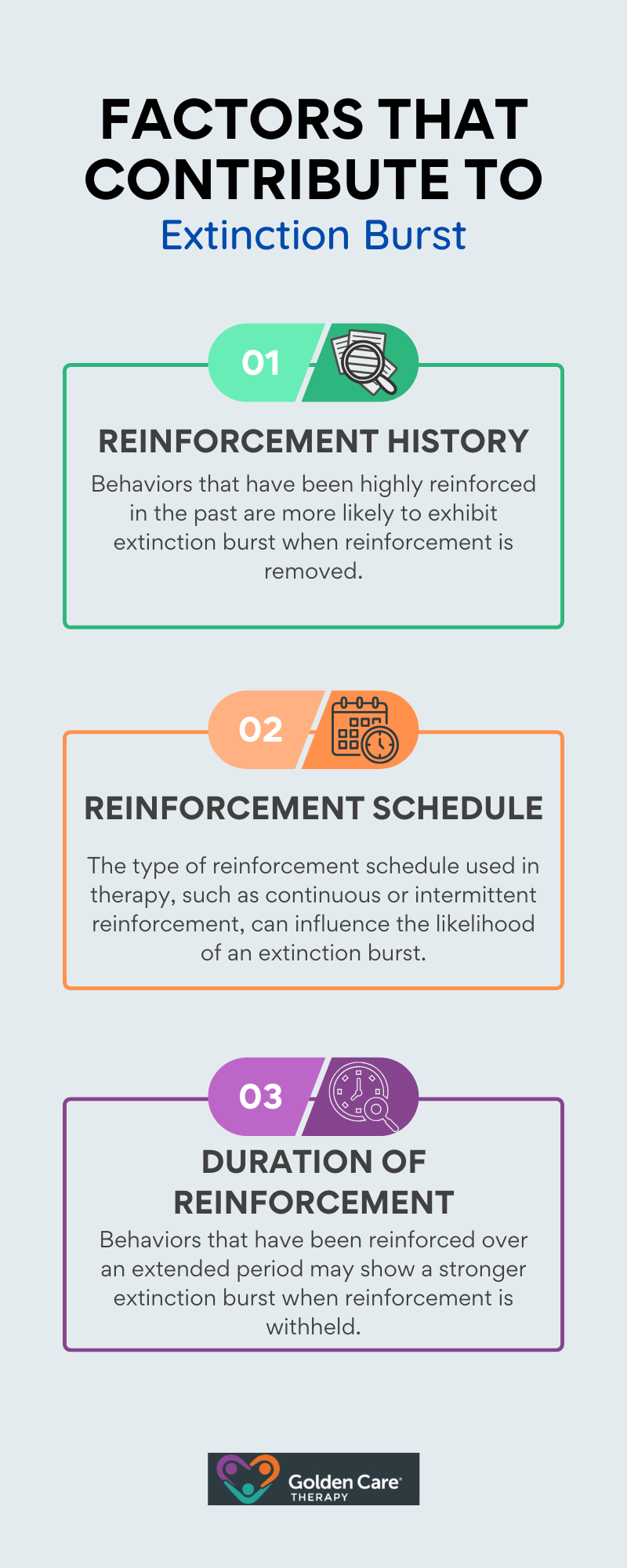Imagine a child who suddenly starts yelling, crying, or throwing a tantrum after they’ve been told no, even though they’ve been told no many times before. A functional analysis can help identify the underlying reasons for this behavior, which might seem like it’s getting worse before it gets better—and that’s exactly what’s happening.
This is known as an “extinction burst,” which is a common part of behavior change, especially in therapy like ABA therapy.
During an extinction burst, behaviors that were previously reinforced stop getting attention, causing the child to briefly increase their efforts to get the reaction they want. Understanding this phenomenon helps parents, teachers, and therapists manage these moments effectively as they work toward lasting behavior change.
What is Extinction Burst in ABA?
In the context of ABA therapy, extinction burst refers to a temporary increase in the frequency, intensity, or duration of a behavior that is being targeted for reduction or elimination.
This escalation in behavior often occurs when the individual no longer receives the reinforcement or response that previously maintained the behavior. Instead of the behavior decreasing immediately, it initially spikes before gradually decreasing if the reinforcement continues to be withheld consistently.
In an extinction burst, individuals tend to exhibit various behaviors, ranging from mild to more intense reactions. Common responses include an increase in the frequency of the targeted behavior, the introduction of new behaviors, or an escalation in the intensity of the behavior.
These responses can be challenging for both the individual receiving ABA therapy and their caregivers, as the temporary increase in unwanted behaviors can be confusing and distressing.
Understanding the definition and behavioral response associated with extinction burst is essential for caregivers, therapists, and individuals undergoing ABA therapy. By recognizing and addressing extinction burst effectively, it is possible to navigate through this phase and work towards achieving behavioral goals in a structured and supportive manner.
Why Extinction Burst Occurs
Understanding the reasons behind the occurrence of extinction bursts is crucial in the context of ABA therapy.
Extinction burst is a phenomenon rooted in behavioral psychology that occurs when a previously reinforced behavior is no longer rewarded. In response to the absence of reinforcement, the individual may exhibit an initial increase in the frequency, intensity, or duration of the behavior before it eventually decreases or extinguishes.
Behaviors that have been consistently reinforced are more likely to exhibit extinction bursts when the reinforcement is abruptly discontinued. This temporary escalation in the behavior can be challenging for both the individual receiving therapy and their caregivers.
Understanding the behavioral principles at play during an extinction burst can help in effectively managing and addressing the behavior.
Several factors can contribute to the occurrence and intensity of extinction bursts in ABA therapy. These factors include:

Recognizing these contributing factors is crucial for therapists, caregivers, and individuals undergoing ABA therapy to proactively address extinction bursts and implement strategies to mitigate their effects.
Building awareness of the behavioral principles and factors influencing extinction bursts is essential for fostering a supportive and successful therapeutic environment.
How to Manage Extinction Burst
Managing extinction bursts is a critical component of behavior modification. By understanding effective strategies for addressing extinction bursts and recognizing the importance of consistency in these approaches, caregivers and therapists can navigate challenging behaviors with patience and skill.
Once faced with extinction burst behaviors, it is essential to employ targeted strategies to address and eventually diminish these responses. One common approach is differential reinforcement, where desired behaviors are reinforced while undesired behaviors are ignored.
This method helps to shape positive behaviors by redirecting attention and reinforcement towards appropriate actions.
Another effective strategy is functional communication training, which focuses on teaching individuals alternative, socially acceptable ways to express their needs and desires. By equipping individuals with effective communication skills, they are less likely to resort to challenging behaviors during extinction burst periods.
Moreover, gradual fading can be utilized to slowly reduce reinforcement for a behavior, helping individuals adjust to changes without experiencing a sudden increase in challenging behaviors. This method allows for a smoother transition towards more adaptive behaviors over time.
Consistency is also key when addressing extinction bursts in ABA therapy. Maintaining a consistent approach to behavior management helps create a stable and predictable environment for individuals with autism. By responding to behaviors in a consistent manner, caregivers and therapists reinforce the expectations and boundaries set forth during therapy sessions.
Consistency also plays a crucial role in promoting generalization of learned behaviors. When interventions are consistently implemented across various settings and with different individuals, the likelihood of sustained behavior change increases.
This continuity helps individuals with autism generalize their skills to real-life situations, fostering independence and success outside of therapy sessions.
In summary, by implementing targeted strategies for addressing extinction bursts and emphasizing the importance of consistency in behavior management, caregivers and therapists can navigate challenging behaviors in ABA therapy.
With patience, dedication, and a steadfast commitment to supporting individuals with autism, managing extinction bursts can lead to positive outcomes and enhanced quality of life for all involved. At Golden Care Therapy ABA, we are proud to offer top-notch ABA therapy in Georgia, New Jersey, Indiana, New York, and Florida.
Our experienced team provides personalized, evidence-based therapy designed to make meaningful improvements in the lives of those we serve. Don’t hesitate to contact us today to learn more about how our services can benefit you and your loved ones.
Sources:



